Damage from Atomic bombing
The Damage
The atomic bomb was dropped on Hiroshima at 8:15 a.m., August 6, 1945. It detonated 600 meters in the air. Though we don't know exactly how many perished in the bombing, it is estimated that 140,000 (plus or minus 10,000) had died by the end of December 1945.
See what Hiroshima looked like after the atomic bomb exploded.
Hiroshima two months after the bombing
Photo by Harbert F. Austin Jr.
Courtesy of Bred M. Austin
Collection of Hiroshima Peace Memorial Museum
Characteristics of Atomic bomb Damage
The atomic bomb was quite different from all previous bombs. At the moment of detonation, a large amount of radiation and heat rays were emitted. As the rising temperature expanded the surrounding air, it generated a tremendous blast. The complex interaction of these factors amplified the damage.
The three energies─radiation, heat ray, and blast ─caused instantaneous mass destruction and indiscriminate mass slaughter.
Breakdown of the A-bomb Energy Released
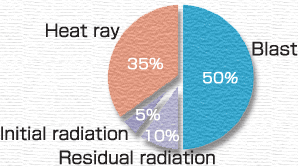
Damage from Radiation
The atomic bomb differed from previous bombs that used chemical explosives. It emitted energy at an entirely different level of magnitude, and it also emitted radiation. In Hiroshima, a vast amount of initial radiation was emitted from the start of the chain reaction to one minute after the explosion. It caused terrible injuries to people's bodies. Almost all those who directly absorbed the radiation within one kilometer of the hypocenter died.
Residual radiation remained in the city. Because of this, even people who were not directly exposed but who came near the hypocenter for rescue and relief operations or to search for their families absorbed radiation. Many fell ill and some died.
Residual Radiation
Residual radiation includes both radiation emitted by radioactive materials created by nuclear fission and unfissioned uranium. It also includes the radiation emitted by radioactive materials generated by nuclear reaction to the initial radiation (the nuclei in atoms that comprise dirt, rubble, etc.)
Soldier with Purpura, "Spots of Death"
September 3, 1945
This man was exposed in a house within one kilometer of the hypocenter. Ten days after the bombing, his hair began falling out and he bled from the gums. Blood collecting under his skin formed purple spots. His gums bled continuously. He died about one month after the bombing.
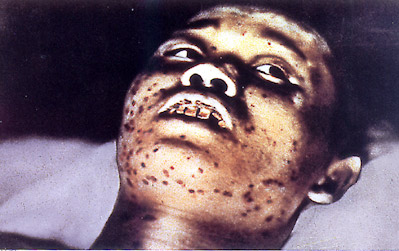
Photo by Gonichi Kimura
Black Rain
A sticky black rain fell over people fleeing the fires that followed the explosion of the atomic bomb.
Survivor testimonies vary as to when and where the black rain fell.
Analysis of the Atomic Bomb Survivor's Health Awareness Survey conducted by Hiroshima City in fiscal 2008 indicated that black rain may have fallen in the area circled in red.
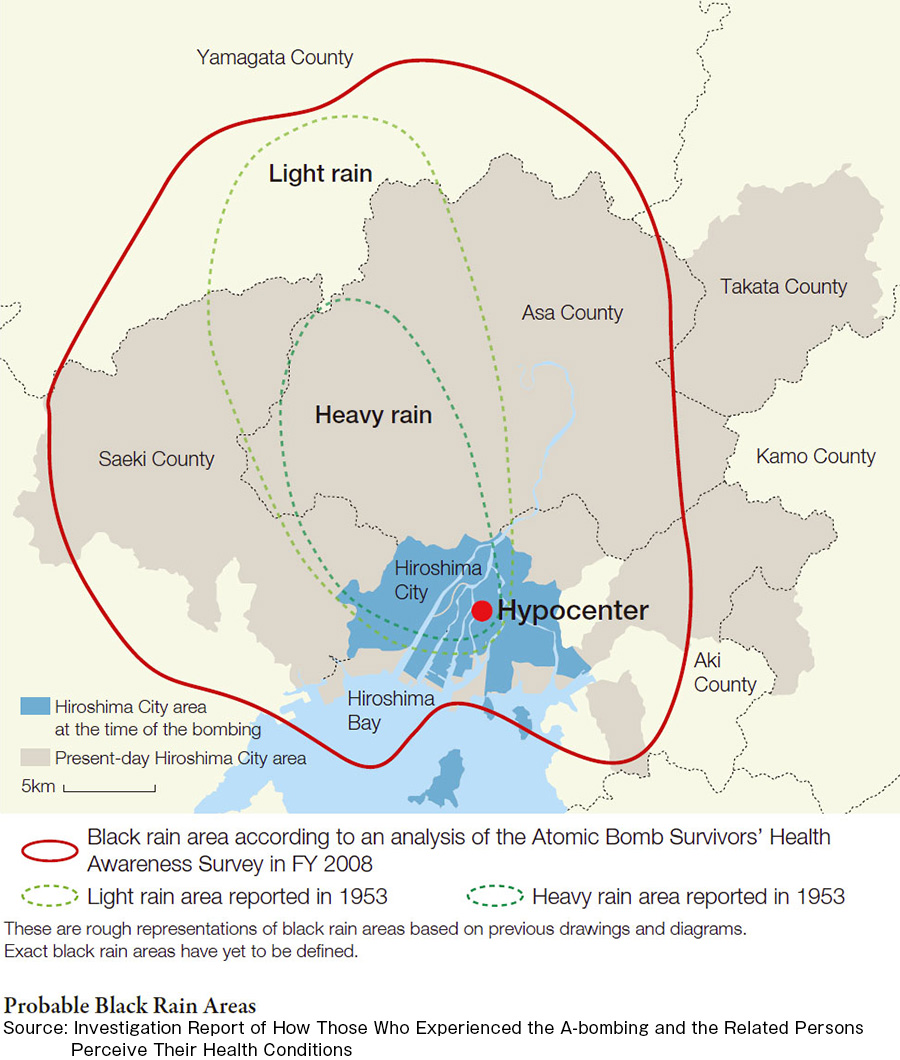
Damage from the Heat Ray
The temperature at the center of the fireball generated by the atomic bomb at the moment of detonation reached millions of degrees Celcius. One second later, the fireball had grown to a radius more than 200 meters. The fierce heat ray emitted from that fireball raised surface temperatures at the hypocenter to 3,000°C to 4000°C. (The surface temperature of the sun is 5,700°C; iron melts at 1500°C.)
A Schoolgirl with Burns
August 9 to 12, 1945
Those exposed to the ferocious heat ray sustained serious burns. Within 1.2 kilometers of the hypocenter, people directly exposed without shielding were burned through all layers of skin and into the tissue blow . Virtually everyone burned in this way died immediately or within a few days.
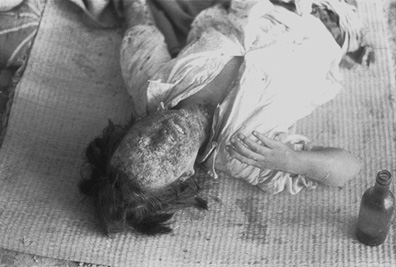
Photo by Hajime Miyatake
Courtesy of Asahi Shimbun
All rights reserved by the Asahi Shimbun.
A man burned by the heat ray except where his waistband covered him
August 7, 1945
This man exposed within a kilometer of the hypocenter was critically burned over his whole body except where his waistband covered him.
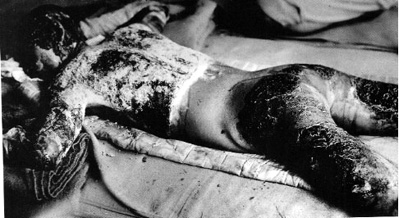
Photo by Masami Onuka
This woman's kimono pattern was burned into her skin.
Around August 15, 1945
Because dark colors absorb heat more readily than light colors, the heat ray burned the dark parts of this woman's kimono pattern into her skin.
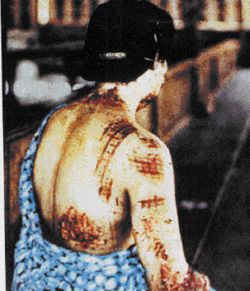
Photo by Gonichi Kimura
Shadow of the bridge railing
Around November 1945
The heat ray scorched and blackened the asphalt, but it remained white where the bridge railing blocked the rays.

Photo by the U.S. military
Damage from the Atomic Bomb Blast
At the instant of detonation, the heat expanded the air suddenly, generating a blast carrying pressure of several hundred thousand atmospheres. At 500 meters from the hypocenter, the atmospheric pressure per square meter was a huge 11 tons, powerful enough to collapse almost every structure. People were killed when the blast threw them or collapsed the buildings they were in.
The Workings of the Atomic Bomb Blast
- The atomic bomb exploded.
- A super-hot fireball was generated, expanding the surrounding air with ferocious power.
- A wall of air spread faster than sound.
- The air behind this wall was a blast.
- As the blast spread, the air pressure near the hypocenter plummeted from high to low in an instant (creating negative pressure).
- The air blowing out from the hypocenter reversed direction; wind swept back in toward the center with tremendous force.
- Negative pressure worsened the damage caused by the blast.
Bent Iron Girders (330 meters from the hypocenter)
The iron frame in the ceiling of the top floor of the Hiroshima Fukoku building was greatly bent by the powerful blast.
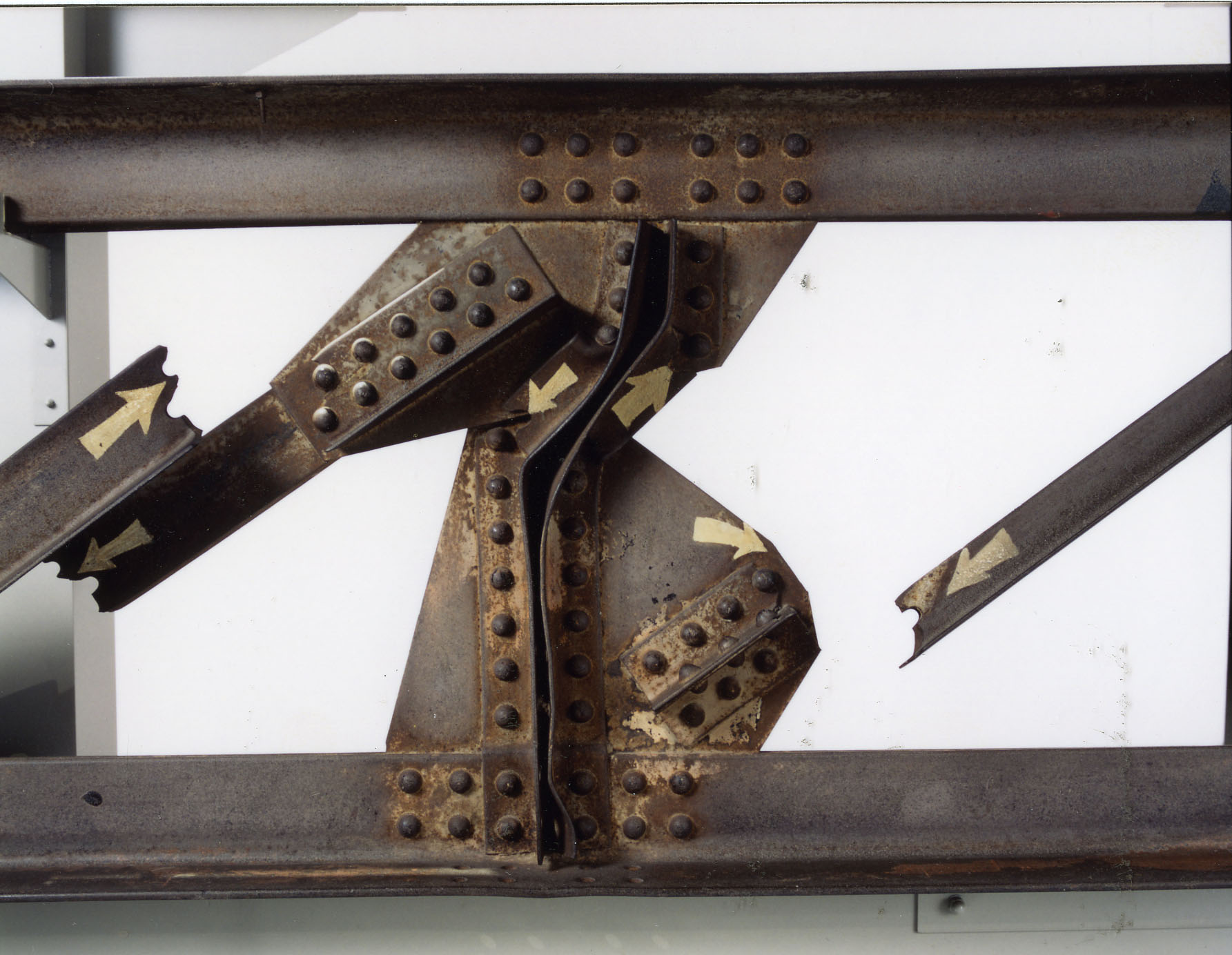
Donated by Fukoku Mutual Life Insurance Company
Glass removed from people's bodiesThe powerful blast splintered glass into tiny fragments that pierced people's bodies. Even now some survivors have glass embedded in their bodies.
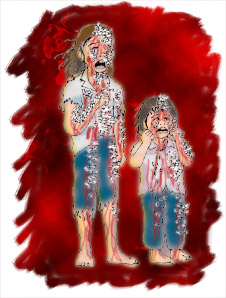
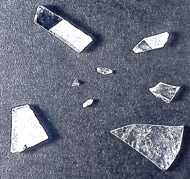
Glass fragments removed from bodiesDonated by Yoshi Fujikawa
(Collection of Hiroshima Peace Memorial Museum)
The blast knocked the roof off this building (roughly 360 meters from the hypocenter).The interior of the Hiroshima Branch of the Teikoku Bank. Both ceiling and floor were blown away by the blast.
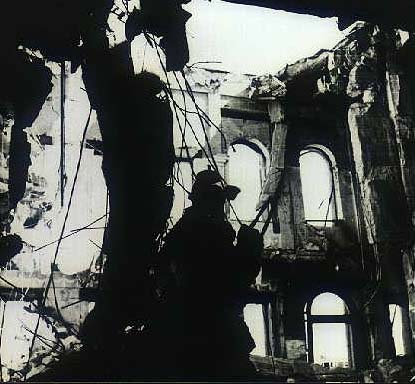
Photo by Toshio Kawamoto
Courtesy of Yoshio Kawamoto
Firestorm
The heat ray generated simultaneously with the explosion of the atomic bomb caused houses, etc., in the hypocenter vicinity to ignite spontaneously. Kitchen flames in houses collapsed by the blast spread and began to consume houses here and there. Such fires rapidly enveloped Hiroshima City in a day-long conflagration that peaked from around 10:00 a.m. to 2:00 or 3:00 p.m. Areas within a two-kilometer radius of the hypocenter were reduced to rubble. Many people trapped under houses collapsed by the blaze were burned alive.
The Damaged Area
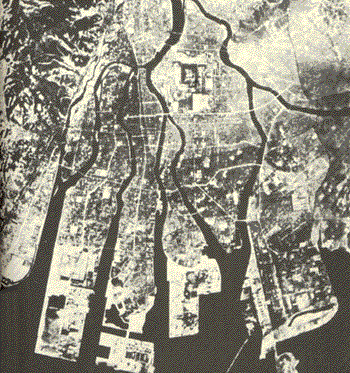
Photo by the U.S. military
Courtesy of the U.S. National Archives and Records Administration
The Scorched Plain of HiroshimaThe T-shaped Aioi Bridge in the center of the photo is the target of the bombing. The land mass lying behind the bridge and sandwiched between two rivers is Nakajima-District (the present Peace Memorial Park).

Photo by the U.S. military
The Skies over Hiroshima
Sadako's Exposure to the Atomic Bomb
Sadako's house burned down and her grandmother died.
The atomic explosion knocked over most of the houses in Sadako's neighborhood. Her own house was leaning precariously. The flames that soon leapt up here and there grew into a huge fire that consumed Sadako's house and the Sasaki Barbershop. The family had escaped by that time, but Sadako's grandmother returned home and was burned to death.
Fujie, the daughter of Chizuko, who ran the barbershop together with Mrs. Sasaki, had left her school to participate in building demolition. She was exposed at the demolition site. Though Fujie was being cared for at a temple in the suburbs, by the time Mr. Sasaki hurried out there to get her, she was already dead. Sadako lost 12 relatives to the atomic bombing. Because Sadako's family had lost their house, they moved in with Mrs. Sasaki's parents (Sadako's grandparents) in the northern part of Hiroshima Prefecture.
The place where Sadako and her family were caught in the black rain
Fleeing the firestorm after the atomic bombing, Sadako, her mother and her older brother ran to a river. At the riverbank, they climbed onto a small, rickety boat that took them out to the middle. It was there that they encountered the highly radioactive black rain falling in enormous drops.
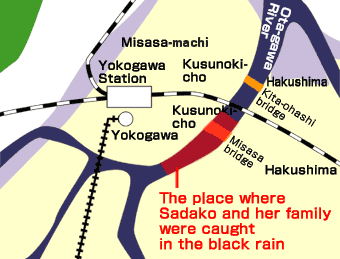
Area where Sadako's house was located after the Bombing
The arched bridge in the middle of the picture is Yokogawa Bridge. Sadako's house was in the Kusunoki-cho area, shown at upper right of the picture.
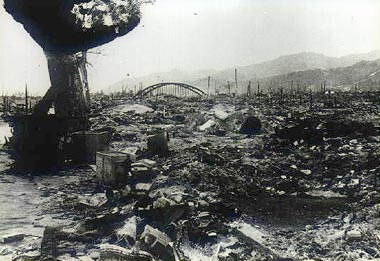
Looking south-west, 1.5km from the hypocenter
20 August 1945
Photo by Masami Oki
Courtesy of Association of the Photographers of the Atomic (Bomb) Destruction of Hiroshima
Rescue and relief activities
There weren't enough relief stations, rescuers, or medicines.
In an instant, the atomic bomb destroyed the center of Hiroshima City. With the Prefectural Government office, City Hall, police stations, and all other public facilities wiped out, the city was in complete confusion.
Starting right after the bombing, however, army units from the south that had only suffered slight damage and other volunteers began efforts to rescue and relieve the bombing victims.
Hospitals and schools that had escaped the fires were turned into temporary relief stations, and many sufferers came every day for treatment. This continued even after the war ended. However, medical supplies grew even more scarce. Adequate care could not be provided to the victims.
Dr. Marcel Junod, Chief Representative to Japan of International Committee of the Red Cross, arranged to send medical supplies on a massive scale. His efforts enabled treatment to continue.
Medical supplies provided through the efforts of Dr. Marcel Junod
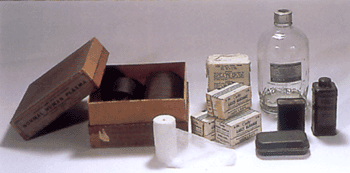
Donated by Masaru Matsunaga
(Collection of Hiroshima Peace Memorial Museum)
A Relief Station
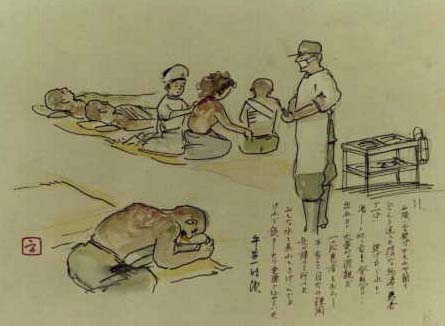
Drawing by Yoshio Takahara

